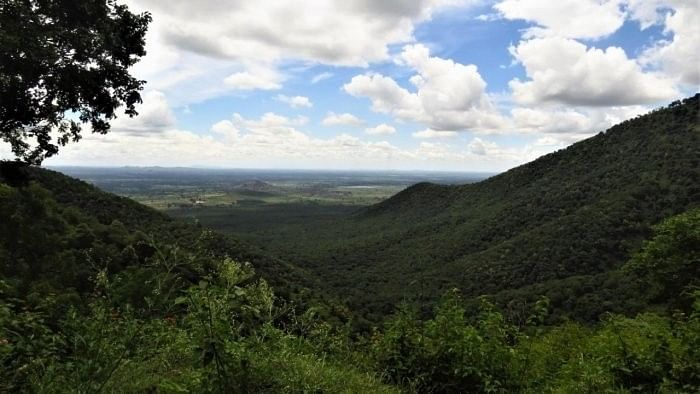
Parliament passed the controversial amendment to the Forest Conservation Act, 1980, a move that will open up the floodgates to ecological disasters.
credit: DH Photo
August 4 this year was a very important day for those concerned with the preservation of India’s ancient biodiversity because biodiversity is the bedrock of all life on planet Earth and forests play a pivotal role.
Parliament passed the controversial amendment to the Forest Conservation Act, 1980, a move that will open up the floodgates to ecological disasters. Already, the ‘LPG Agriculture’ (Liberalisation, Privatisation and Globalisation Agriculture – read, the highly soil extractive, chemically-centric farming, euphemistically called the ‘green revolution’, an American brainchild of the ‘land grant pattern’) in India, starting mid-sixties, has ruined our soils and that of South Asia.
Of India’s 328.73 million hectares of geographical area, more than 120.40 million hectares — that is almost a third of the entire geographical area, has degraded soils — thanks to the green revolution. The soils are degraded, the groundwater is polluted, not potable and loaded with residues of unbridled use of synthetic fertilisers,
pesticides and herbicides. In fact, Gurdaspur district has become the ‘capital’ of Indian cancer.
The current amendment completely overhauls the 1980 Act for the first time, not only by merely changing its name but also by opening up swathes of India’s forestland for very different, non-forest activities.
Most importantly, it narrows the definition of forests in the country, striking at the very roots of forest biodiversity. Forest biodiversity is the bedrock of all life on Earth and the entire topic of biodiversity is discussed in a book written by this author titled ‘Biodiversity in Agriculture – Sustainability of Soil, Soil Fauna and Flora’.
There are many concerns in the amended Act, but the most important is the amendment under the garb of clarifying what constitutes a forest, which limits the scope of the Act. This is being done in multiple ways. The current amendment will benefit the corporates more than the country. Forests are already being diverted by state governments for mining. This Act will make such actions legally valid.
In addition to restricting the definition of a forest, the amendment also permits development of various activities in existing forests. For example, forest clearances are no more required for security-related infrastructure projects that lie within 100 kilometres of international borders.
These areas can be used for “construction of strategic linear projects of national importance and concerning national security”. Several border states, including Sikkim, Mizoram, Tripura and Himachal Pradesh, registered their opposition to this exemption to the parliamentary committees examining the amended Act, to no avail. The Northeast, one of the most biodiversity rich areas of the country, has already lost 3,199 square kilometers of forest area between 2009 and 2019. This new Act will make the Northeast region vulnerable to further loss of forest cover, and the adverse effect on forest biodiversity can only be imagined.
India has many biodiversity-rich ‘hotspots.’ In fact, the phrase “strategic linear project of national importance” in the new Act can mean anything.
The Act has also exempted non-forest activities, such as agro-forestry plantations, and, in particular, ecotourism from environmental clearances. This last mentioned is the most problematic.
The Kerala tourism minister’s initiative in ecotourism, which has substantial forestland in specific areas of the state, is even leading to drug trafficking, and, not to mention, the habitational mental injury inflicted on animals that inhabit the neighbouring areas.
The exemptions under the Act are given on the condition that the diverted forestland will be compensated for by the planting of trees elsewhere in the country. But tree planting is no substitute for forest land. Anyone even with an elementary understanding of forest biodiversity would know this.
The new Act will, without doubt, erode the rights guaranteed to indigenous and forest-dwelling communities over forests.
Under the Scheduled Tribes and Other Traditional Forest Dwellers (Recognition of Forest Rights) Act of 2006 or the Forest Rights Act of 2006, the consent of gram sabhas is essential for getting environmental clearance for any project to be implemented.
If such land is not recognised in government records as forest lands, then developmental projects might not even need a clearance anymore. If the definition is adopted from the Forests Right Act of 2006, then the rights of these people will be ensured; if not done so, it will be threatened.
The new Act has raised deep concerns about the ownership of local forestland, where special provisions such as the Sixth Schedule and Article 371 help to protect the community land ownership and cultural practices. These value systems not only have a great cultural bearing but also a far greater spiritual bearing as well because of deep religious beliefs and sentiments.
The sacred groves or ‘Kavus’ in Kerala have deep religious connection since
time immemorial.
The latest amendment has inserted a preamble to the Act that talks about the role of forests in achieving the national goal of “Net Zero Emission by 2070”, and the creation of a carbon sink of an additional 2.5-3.0 billion tonnes of carbon dioxide equivalent by 2030. The government claims that exempting “forest-like regions” would see more investment in plantations and other tree cover, which will, in turn, improve the carbon sink capabilities of India in the battle against global warming.
But the provisions in the amendments completely contradict the spirit of the preamble and conservation of forests. In an attempt to fulfil a commitment to create carbon sinks, the Act demolishes India’s commitment under the Convention on Biological Diversity (COBD) goals of in-situ conservation, indigenous rights, equitable sharing of benefits and protecting biodiversity — the bedrock of all life on Earth.
(The writer is former professor,
National Science Foundation, The Royal Society, Belgium)